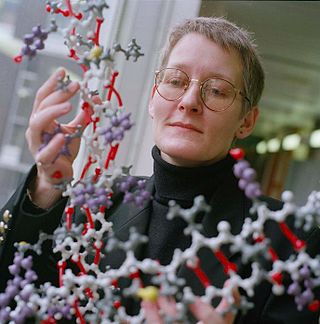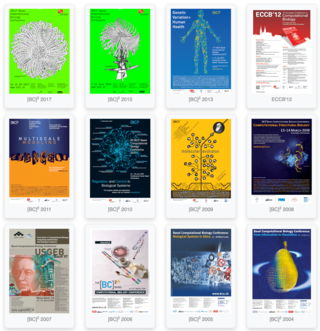History
The institute was originally created to provide a framework for stable long-term funding for both the Swiss-Prot database and the Swiss EMBnet node. Swiss-Prot in particular went through a major funding crisis in 1996, [1] which led the leaders of the five research groups active in bioinformatics in Geneva and Lausanne, Ron Appel, Amos Bairoch, Philipp Bucher, Victor Jongeneel and Manuel Peitsch to create SIB. [2] Once created, the institute could then apply for funding under a Swiss law that allows the government to fund up to 50% of expenses of vital research and teaching infrastructures. [3]
The first director of the institute was Victor Jongeneel followed by Ernest Feytmans between 2001 and September 2007. From 1 October 2007 until July 2018, the institute was led by Ron Appel, one of its founding members. [4] [5] Between July 2018 and March 2022, the SIB was led by Christine Durinx and Ron Appel, as Joint Executive Directors. Starting 1st April 2022, Christophe Dessimoz replaced Christine Durinx as joint executive director. [6] . Since October 2022 Christophe Dessimoz is sole Executive Director, following the retirement of Ron Appel [7] .
Organisation
The SIB Swiss Institute of Bioinformatics is a federation of research groups with affiliated bioinformaticians at 21 SIB partner institutions, including the Universities of Basel, Bern, Fribourg, Geneva, Lausanne, Lugano and Zurich, the Federal Institutes of Technology in Lausanne and Zurich, the Friedrich Miescher Institute for Biomedical Research, the Institute of Oncology Research in Bellinzona, and the Geneva School of Business Administration (HEG). Current research groups in SIB are located in Basel, Bern, Fribourg, Geneva, Lausanne, Lugano, Zurich, Yverdon, Wädenswil, Bellinzona and Davos.
SIB federates more than 70 research, service and infrastructure groups, gathering more than 700 scientists in fields as varied as proteomics, transcriptomics, genomics, systems biology, structural bioinformatics, evolutionary bioinformatics, modelling, imaging, biophysics, population genetics and clinical bioinformatics. The SIB organizes an annual international scientific meeting, the [BC]2 Basel Computational Biology Conference.
The institute offers a wide range of resources for the life science research community, most being open and accessible through Expasy, the SIB bioinformatics resource portal. They include:
Databases
SIB develops and maintains databases of international standing, including UniProtKB/Swiss-Prot (curated protein sequence database providing a high level of annotation), neXtProt (human-centric protein knowledge platform), SWISS-MODEL Repository (three-dimensional protein structure models), STRING (protein interaction networks for Systems Biology), SwissRegulon (genome-wide transcription regulatory networks), Eukaryotic Promoter Database (EPD), SWISS-2DPAGE (2D gel database), WORLD-2DPAGE Repository (2D gel repository), PROSITE (protein families and domains), MyHits (protein sequences and motifs), Bgee (database to retrieve and compare gene expression patterns between animal species), OpenFlu (database for human and animal influenza virus), ViralZone (portal to viral UniProtKB entries), GlycoSuiteDB (glycan database), SugarBindDB (Pathogen Sugar-Binding Database), OrthoDB (the hierarchical catalogue of eukaryotic orthologs), miROrtho (the catalogue of animal microRNA genes), ImmunoDB (insect immune-related genes and gene families) and Cellosaurus (a knowledge resource on cell lines).
SIB develops and supplies software for the global life science research community, such as SWISS-MODEL (protein structure homology modelling), SwissDrugDesign (computer-aided drug design), Melanie (2D gel analysis platform), MSight (LC-MS imaging and analysis software), OMA (Orthology Matrix), V-pipe (viral genomics pipeline), DeepView/Swiss-PdbViewer (protein visualization, modelling and analysis), and Newick utilities (high-throughput phylogenetic tree processing).
Core facilities
SIB manages several bioinformatics core facilities that provide informatics and statistical support, as well as services and advice to life scientists, thus enabling them to conduct their research projects and analyse the resulting data. Core facilities have been set up for genomics, transcriptomics and proteomics research. SIB also maintains the Vital-IT High Performance Computing Centre that provides computational resources, development support and consultancy to the Swiss life science community both in academia and industry. The Vital-IT infrastructure is distributed to three sites: University of Lausanne, EPFL and University of Geneva. Compute resources and bioinformatics expertise are also provided in the Basel area with sciCORE, the Basel Computational Biology Center.

Bioinformatics is an interdisciplinary field of science that develops methods and software tools for understanding biological data, especially when the data sets are large and complex. Bioinformatics uses biology, chemistry, physics, computer science, computer programming, information engineering, mathematics and statistics to analyze and interpret biological data. The subsequent process of analyzing and interpreting data is referred to as computational biology.

The National Center for Biotechnology Information (NCBI) is part of the United States National Library of Medicine (NLM), a branch of the National Institutes of Health (NIH). It is approved and funded by the government of the United States. The NCBI is located in Bethesda, Maryland, and was founded in 1988 through legislation sponsored by US Congressman Claude Pepper.

UniProt is a freely accessible database of protein sequence and functional information, many entries being derived from genome sequencing projects. It contains a large amount of information about the biological function of proteins derived from the research literature. It is maintained by the UniProt consortium, which consists of several European bioinformatics organisations and a foundation from Washington, DC, United States.
The European Bioinformatics Institute (EMBL-EBI) is an intergovernmental organization (IGO) which, as part of the European Molecular Biology Laboratory (EMBL) family, focuses on research and services in bioinformatics. It is located on the Wellcome Genome Campus in Hinxton near Cambridge, and employs over 600 full-time equivalent (FTE) staff. Institute leaders such as Rolf Apweiler, Alex Bateman, Ewan Birney, and Guy Cochrane, an adviser on the National Genomics Data Center Scientific Advisory Board, serve as part of the international research network of the BIG Data Center at the Beijing Institute of Genomics.

Amos Bairoch is a Swiss bioinformatician and Professor of Bioinformatics at the Department of Human Protein Sciences of the University of Geneva where he leads the CALIPHO group at the Swiss Institute of Bioinformatics (SIB) combining bioinformatics, curation, and experimental efforts to functionally characterize human proteins.

PROSITE is a protein database. It consists of entries describing the protein families, domains and functional sites as well as amino acid patterns and profiles in them. These are manually curated by a team of the Swiss Institute of Bioinformatics and tightly integrated into Swiss-Prot protein annotation. PROSITE was created in 1988 by Amos Bairoch, who directed the group for more than 20 years. Since July 2018, the director of PROSITE and Swiss-Prot is Alan Bridge.
Expasy is an online bioinformatics resource operated by the SIB Swiss Institute of Bioinformatics. It is an extensible and integrative portal which provides access to over 160 databases and software tools and supports a range of life science and clinical research areas, from genomics, proteomics and structural biology, to evolution and phylogeny, systems biology and medical chemistry. The individual resources are hosted in a decentralized way by different groups of the SIB Swiss Institute of Bioinformatics and partner institutions.
The Association of Biomolecular Resource Facilities (ABRF) is dedicated to advancing core and research biotechnology laboratories through research, communication, and education. ABRF members include over 2000 scientists representing 340 different core laboratories in 41 countries, including those in industry, government, academic and research institutions.
Marc R. Wilkins is an Australian scientist who is credited with the defining the concept of the proteome. Wilkins is a Professor in the School of Biotechnology and Biomolecular Sciences at the University of New South Wales, Sydney.
neXtProt is an on-line knowledge platform on human proteins. It strives to be a comprehensive resource that provides a variety of types of information on human proteins, such as their function, subcellular location, expression, interactions and role in diseases. The major part of the information in neXtProt is obtained from the UniProt Swiss-Prot database but it is complemented by data originating from high-throughput studies with an emphasis on proteomics. neXtProt offers also an advanced search capacity based on the SPARQL technology as well as an API that allows to programatically extract the data stored in the resource. It is developed by the CALIPHO group directed by Amos Bairoch and Lydie Lane of the Swiss Institute of Bioinformatics (SIB).

Rolf Apweiler is a director of European Bioinformatics Institute (EBI) part of the European Molecular Biology Laboratory (EMBL) with Ewan Birney.
SWISS-MODEL is a structural bioinformatics web-server dedicated to homology modeling of 3D protein structures. Homology modeling is currently the most accurate method to generate reliable three-dimensional protein structure models and is routinely used in many practical applications. Homology modelling methods make use of experimental protein structures ("templates") to build models for evolutionary related proteins ("targets").

Teresa K. Attwood is a professor of Bioinformatics in the Department of Computer Science and School of Biological Sciences at the University of Manchester and a visiting fellow at the European Bioinformatics Institute (EMBL-EBI). She held a Royal Society University Research Fellowship at University College London (UCL) from 1993 to 1999 and at the University of Manchester from 1999 to 2002.

Ron David Appel is a Swiss bioinformatician, professor of proteomics and bioinformatics at the University of Geneva and executive director of the Swiss Institute of Bioinformatics.
Continuous Automated Model EvaluatiOn (CAMEO) is a community-wide project to continuously evaluate the accuracy and reliability of protein structure prediction servers in a fully automated manner. CAMEO is a continuous and fully automated complement to the bi-annual CASP experiment.

The Basel Computational Biology Conference is a scientific meeting on the subjects of bioinformatics and computational biology. It covers a wide spectrum of disciplines, including bioinformatics, computational biology, genomics, computational structural biology, and systems biology. The conference is organized biannually by the SIB Swiss Institute of Bioinformatics in Basel, Switzerland.

Proline-rich basic protein 1(PROB1) is a protein encoded by the PROB1 gene located on human chromosome 5, open reading frame 65. PROB1 is also known as C5orf65 and weakly similar to basic proline-rich protein.

Christophe Dessimoz is a Swiss National Science Foundation (SNSF) Professor at the University of Lausanne, Associate Professor at University College London and a group leader at the Swiss Institute of Bioinformatics. He was awarded the Overton Prize in 2019 for his contributions to computational biology. Starting in April 2022, he will be joint executive director of the SIB Swiss Institute of Bioinformatics, along with Ron Appel.
In molecular biology, MvirDB is a publicly available database that stores information on toxins, virulence factors and antibiotic resistance genes. Sources that this database uses for DNA and protein information include: Tox-Prot, SCORPION, the PRINTS Virulence Factors, VFDB, TVFac, Islander, ARGO and VIDA. The database provides a BLAST tool that allows the user to query their sequence against all DNA and protein sequences in MvirDB. Information on virulence factors can be obtained from the usage of the provided browser tool. Once the browser tool is used, the results are returned as a readable table that is organized by ascending E-Values, each of which are hyperlinked to their related page. MvirDB is implemented in an Oracle 10g relational database.

C1orf159 is a protein that in human is encoded by the C1orf159 gene located on chromosome 1. This gene is also found to be an unfavorable prognosis marker for renal and liver cancer, and a favorable prognosis marker for urothelial cancer.













